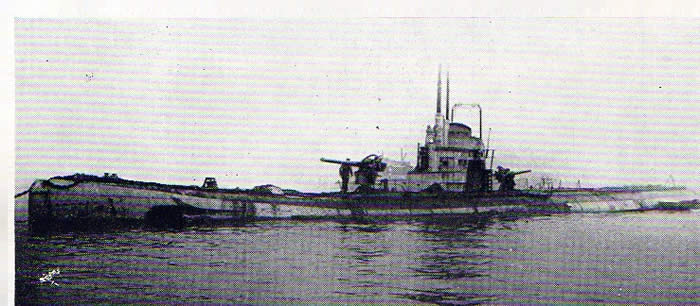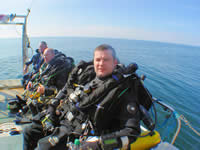
U92

The U92 was lost in the Northern Barrage on or around 9th September 1918. She was outward bound to her patrol area and was lost with her entire crew of 42. Including her commander Gunther Ehrilich who had commanded her from the 1st June that year.
The U92 was built in Kaiserliche Werft, Danzig shipyard in 1917. During her career she completed 5 patrols when she sunk 6 ships.
On the Friday the 15th June 2007 a team of divers led by Paul Warren, also in the dive team were Ric Warning and Steve Slater dived the U92 for the first time. For identification purposes a small piece of a ready use ammunition canister for a 88mm gun was recovered then photographed and returned to the wreck site!. This along with the position of the u boats armament and this U-Boats position in the Northern Barrage
Area B has proved this to be the U92. The receiver of wreck and also the German Government have been informed of the findings.
Ever since I first started diving, nearly twenty years ago, it had been an ambition of mine to dive a virgin U-boat. The very name stirs the imagination and conjures pictures of silent, deadly, machines slipping into the black ocean on a moonless night.
As the years had passed I thought for certain that the opportunity had long since disappeared. How wrong could I be!!
As I write this it is nearly 4 hours since I surfaced from one of the greatest dives of my life and I am still breathless at the sights I have just witnessed.
Lying east of the Orkneys, in just over 80 metres of water, lies what we believe to be the remains of U 92, lost in September 1918. Andy Cuthbertson, skipper of the Jean Elaine, had supplied us with sonar traces and plans, making sure we were well prepped for the dive that lay ahead.
We hit the water slightly after 8.30 am and headed down the shot. First class visibility greeted us as I could easily make out Ric a few metres below as we both descended; eager to see what awaited us.
The tide was pulling as I hit the sea-bed at just under 81 metres. The shot was resting on a clean sand bottom and an old, abandoned fishing net lay near by. I barely registered these facts, however, as I gazed in awe at the sight no more than 3 – 4 metres in front of me.
I have heard divers tell how U-boats give off their own aura, as if they are about to start up again and, to be honest, always thought it was fanciful thinking. Now I knew the truth as in front of me, silent and menacing, lay one of Kaiser Wilhelm’s notorious submarines. My Grandfather had served in the Royal Navy in WW1 and my Uncle in WW2 and both had talked of the evil, menacing presence of U-boats and now that I was witnessing one of these submarines first hand the frightening reputation of the boat I now stared at was not lost on me.
Mostly intact (some damage where to her bow section), U 92 is a lot larger than I imagined. Some plates have rotted off the outside hull, revealing the inner pressure hull but, other than that, she is intact. Clipping a line on to the shot, I headed up the hull to the aft gun, which was easily visible in the 8 – 10 m visibility.
Having inspected the workings I passed munitions lying on the deck before coming to the conning tower complete with small portholes. A small periscope gazed out into the black sea as it had done for the last 90 years. The hatch was firmly closed, baring witness that none of the German sailors managed to escape, and that she is now a tomb to her officers and men.
Heading foreword I came to another gun but, all too soon, my time was running out. I dropped back to the sea- bed as I reeled my line in so that I could once more gaze in wonder at this amazing sight before beginning my long decompression schedule. My only regret was that I did not make it to the bow or stern as we believe the former is the area damaged when she detonated the mine.
So how do I sum up this dive? Exciting, emotional, exhilarating, menacing? All these things, yet there was something more, something I just can’t describe.
The Northern Barrage
In 1918 it was decided to blockage the Atlantic by laying a
Wall of mines from Orkney to Norway, this wall would be known at the Northern Barrage and was planned to have 200,000 mines by the end of 1918. The ‘’Barrage’’ would consist of three ‘’Areas’’ known as A,B and C.
The two U boats are in what’s known as Area B. The first mines were laid here at the beginning of September 1918.
The field that the two U boats are in consisted of 1920 mines placed there on the 7th September 1918. U 102 is to the North and hit while homeward bound and the U 92 on the southern edge whilst outward bound to her patrol ground.
UB 127 was listed also as lost in Area B but no trace of her at the western end was found by the MCA 2006 survey
© Scapa Flow Charter unless otherwise stated
Divers top side

Steve Slater, Paul Warren and Ric Warning
With thanks to Kevin Heath for valuable information provided.
Entry from UBoat net on the U92
Link to the crew names of the U92 that were lost
Heikendorf-Möltenort (U-Boot-Ehrenmal), Kreis Plön, Schleswig-Holstein - U-92, 1. Weltkrieg